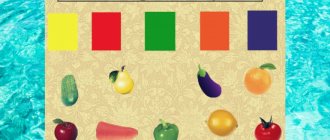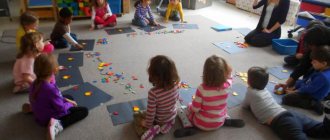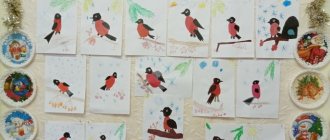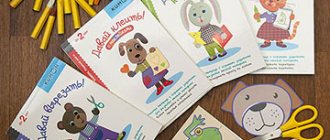Notes on application in the 2nd junior group “Decoration - felt boots”
Notes on application in the 2nd junior group “Decoration - felt boots”
Program content:
“Artistic and aesthetic development”:
1. Strengthen in children the skill of spreading glue on an object and carefully gluing it. Use the acquired skill when creating a pattern to decorate a felt boot.
2. Continue to teach children how to position the pattern correctly and use a napkin when making appliqué.
"Social - communicative":
3. Activate the subject dictionary on the topic “Shoes”, naming geometric shapes. Form an explanatory speech.
"Cognitive development":
4. Develop visual perception, imagination, and the ability to establish cause-and-effect relationships.
"Physical development":
5. Develop fine motor skills of the fingers.
Methods and techniques.
Game situation: the arrival of the dog Sharik to the group, riddle, pictures, questions, explanation of the teacher, clarifications, additions, samples, practical activities, reminders, encouragement.
Health-saving technologies: changing static and dynamic poses, taking into account individual characteristics, finger gymnastics.
Progress of the lesson.
I. - Guys, Sharik came to visit us today and brought an interesting picture. Look at her.
-What do you see on it? (Fence, and legs under the fence).
-What are you wearing on your feet? (Felt boots).
- How many children do you think were hiding behind the fence? (2)
- How did you guess? (Close their eyes, open them - another picture).
-Did you guess correctly?
-Who do you see here?
Look at the bright colorful clothes the children have and the colorful hats they wear. What about felt boots? Are they patterned? (No) .
- Let's teach the kids how to decorate felt boots.
II. - Look how beautiful the pattern is (the teacher displays samples of the drawings).
-What does the pattern look like? (For the New Year tree).
— What geometric shapes is the pattern made of? (From triangles and circles).
— What color are the triangles? (green)
-What color are the circles (yellow, blue, red)
— A felt boot has a toe, a heel, and what part is the pattern on? (in the middle).
III. They sat down on the chairs.
— In front of you are felt boots and triangles.
- What should we do next? (spread with glue).
— How do we spread the glue? (Demonstration of sticking, explanation).
- Glue a large triangle at the bottom, a medium triangle at the top, and a small one at the very top. Glue from bottom to top..
Finger gymnastics “Herringbone”.
IV. Execution of work.
V. Summary of the lesson
- Let's make an exhibition of your works and look at them. Who got the most neat, bright, even pattern?
Author: Pryakhina Irina Olegovna
Unregulated activity “Man-made world: clothes and shoes”
Communication “Man-made world: clothes and shoes”
Monday
Reasoning “What are clothes made of”
Goal: developing ideas about the variety of clothing, the properties and qualities of objects.
Tuesday
Conversation “How girls and boys dress”
Goal: developing awareness of one’s gender identity.
Wednesday
Conversation about the work of a seamstress and shoemaker
Goal: developing ideas about the work of adults as a way of creating objects that people need.
Thursday
Conversation “How we notice disorder in clothes and correct it”
Goal: developing an idea of the need for self-service.
Friday
Sketch “Let's go through the mud” (depicting disgust)
Goal: to cultivate a caring attitude towards clothes and shoes.
Cognitive practical activity “Man-made world: clothes and shoes”
Monday
Examining the fabrics from which clothes are made
Goal: developing the ability to recognize the properties and qualities of objects.
Tuesday
Observing passersby (what they are wearing)
Goal: developing the ability to notice patterns and dependencies of objects and phenomena (if it’s cold, you need warm clothes).
Wednesday
Weather monitoring
Goal: developing the ability to determine the time of year based on characteristic features.
Thursday
Observation "Autumn Shoes"
Goal: developing the ability to notice the dependence of the choice of shoes on the weather (if it rains, you need to put on rubber boots).
Friday
Solving riddles about clothes and shoes
Goal: to consolidate ideas about the variety of clothes and shoes.
Game activity “Man-made world: clothes and shoes”
Monday
Didactic game “dress the doll for a walk”, “Undress the doll after the walk”
Goal: to reproduce in the game actions with toys related to everyday life.
Tuesday
Didactic game “Let’s show Mishka how to dress so as not to catch a cold”
Goal: formation of an algorithm for undressing and dressing.
Wednesday
Didactic game “Let’s iron the doll’s dress”
Goal: developing an understanding of clothing care
Thursday
Didactic game “When is this worn?”
Goal: strengthening the ability to establish a relationship between weather conditions and clothing.
Friday
Didactic game “What’s extra?”
Purpose: comparison of objects by function and purpose.
Artistic activity “Man-made world: clothes and shoes”
Monday
Looking at pictures of clothes and shoes
Goal: developing the ability to see a variety of items of clothing and footwear, to recognize their properties and qualities.
Tuesday
Reading works: “Our Little Masha”, “Shoes” by A. Barto, “My Teddy Bear” by Z. Alexandrova, “Whose Shoes?” N. Pavlova
Goal: introducing children to accessible literary works, developing the ability to answer adult questions.
Wednesday
Listening to the song “Mom Lesha bought excellent galoshes”
Goal: development of the ability to distinguish the nature of music.
Thursday
Listening to a fragment of P. Tchaikovsky’s work “The Seasons” (autumn) with free movements to the music
Goal: development of the ability to distinguish the nature of music.
Friday
Independent art activity with coloring books “Clothes”
Goal: development of the ability to hatch in different directions.
Shoes and hats. Lesson in the younger group
Approximate Basic Educational Program Age group: junior Theme of the educational activity “Shoes and hats” Direction of development – cognitive, speech, artistic and aesthetic. Goal: to create conditions for the formation of general concepts of hats and shoes. Tasks:
- contribute to the accumulation of ideas about hats and shoes.
- To develop the ability to find them in the surrounding (specially created) environment.
- Cultivate a neat, caring attitude towards shoes and hats.
Types of activities: gaming, communicative, motor, visual (drawing), musical. Forms of organization – group. Forms of implementation of children's activities:
- Speech outdoor game “Boots”
- Solving a problem situation
- Painting a boot
Equipment Demonstration - pictures of hats, Panama hats, scarves, baseball caps, felt boots, rubber boots, shoes. Handout – boot template, colored pencils. GCD move
— Guys, do you like to solve riddles? - Yes. Today I will tell you a few riddles, and you try to guess them.
- And in the frost and in the cold
She will always save you, So that your health is not shaky. Put... (a hat) on your head.
- Put it on my head
And run on the hottest day, And if you take it off, mom is unhappy, I am a summer hat (Panama hat).
- Warm, comfortable, keep your feet warm,
They allow you to walk through the snowdrifts for a long, long time (felt boots).
- If it rains we don't bother -
We splash around briskly through the puddles. The sun will begin to shine - We should stand under the coat rack (rubber boots).
-Well done boys! Guessed all the riddles. - Now look and tell me what you see in the pictures? (panama hat, scarf, hat, baseball cap). -What is this all called? — That's right, hats. -What do you see in these pictures? (boots, shoes, felt boots). -What is all this called? - Yes, these are shoes. - Guys, what are hats for? — Put it on your head to keep it warm or to prevent the sun from baking your head. -What are shoes for? - So that your feet don’t freeze, so that they are warm. So that your feet don't get wet. To avoid hurting your feet. - Guys, now take one picture at a time, and where the hat is, put the hats. And where the boot is - shoes. - Well done, everyone completed the task! - Now let’s stand in a circle and play the game “Boots.” You've dressed your feet in new boots, you walk, little feet, straight along the path. You walk, stomp, don’t splash in puddles, don’t walk into the mud, don’t tear your boots. - Guys, come in and take your seats. — Tell me, what are shoes made of? - Made of leather, rubber, fur. — Yes, they use different materials to make the shoes durable and comfortable. —What are the hats made of? — From fabric, yarn, fur. — Yes, also from different materials. — Guys, tell me, how should we handle both hats and shoes? - Yes, be careful, try to be careful, don’t get them dirty or tear them. - And now I invite each of you to decorate the boot. Take a pencil of any color, and music will help you in your work. - Well done boys! What beautiful boots you have made. Everyone did their best. Did you like it today? What exactly did you like? In the evening, you can show the boots to your mothers and tell them what new you learned today.





